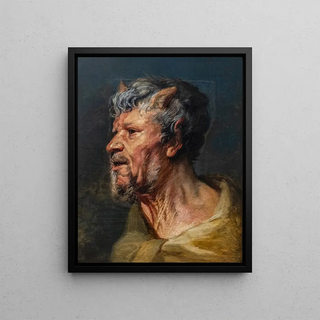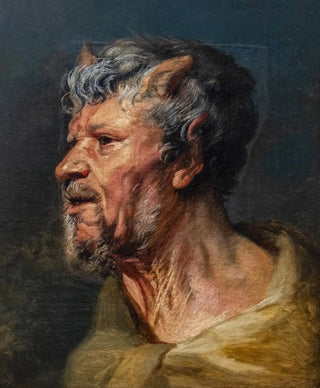Art print | Faun head - Jacob Jordaens


View from behind

Frame (optional)
Jacob Jordaens's "Head of a Faun" is a captivating art print that embodies the very essence of Flemish Baroque art. This depiction of a faun, a mythological creature that is both human and animal, draws the viewer's attention through its expressiveness and depth. Jordaens's mastery in capturing the soul of this character, while playing with shadows and light, immerses us in a universe where nature and mythology intertwine. Contemplating this art print, one cannot help but feel a connection to the world of ancient myths, an invitation to explore the stories that have shaped our culture.
Style and uniqueness of the art print
Jordaens's style is distinguished by bold use of colors and a mastery of textures that give his works unparalleled vitality. In "Head of a Faun," earthy tones and flashes of light blend harmoniously, creating a striking contrast that captures the eye. The depiction of the faun, with its pronounced features and penetrating gaze, reveals a particular sensitivity, a humanity that transcends the boundaries of simple animal representation. Jordaens succeeds in infusing a palpable emotion into this mythological figure, highlighting a duality between savagery and wisdom. This blend of realism and symbolism makes this art print an emblematic example of baroque art, where every detail is loaded with meaning.
The artist and his influence
Jacob Jordaens, born in Antwerp in 1593, is one of the great masters of 17th-century Flemish painting. A pupil of Rubens, he developed a distinctive style characterized by a lively and dynamic approach to composition. Jordaens stands out for his ability to capture the essence of everyday life while incorporating mythological and religious elements. His influence extends far beyond his era, inspiring many artists across the centuries. By integrating folk themes and popular characters into his works, he made art accessible and relevant to a broad audience. The "Head of a Faun" reflects this desire to connect art with popular culture and human nature, an legacy that continues to

Matte finish

View from behind

Frame (optional)
Jacob Jordaens's "Head of a Faun" is a captivating art print that embodies the very essence of Flemish Baroque art. This depiction of a faun, a mythological creature that is both human and animal, draws the viewer's attention through its expressiveness and depth. Jordaens's mastery in capturing the soul of this character, while playing with shadows and light, immerses us in a universe where nature and mythology intertwine. Contemplating this art print, one cannot help but feel a connection to the world of ancient myths, an invitation to explore the stories that have shaped our culture.
Style and uniqueness of the art print
Jordaens's style is distinguished by bold use of colors and a mastery of textures that give his works unparalleled vitality. In "Head of a Faun," earthy tones and flashes of light blend harmoniously, creating a striking contrast that captures the eye. The depiction of the faun, with its pronounced features and penetrating gaze, reveals a particular sensitivity, a humanity that transcends the boundaries of simple animal representation. Jordaens succeeds in infusing a palpable emotion into this mythological figure, highlighting a duality between savagery and wisdom. This blend of realism and symbolism makes this art print an emblematic example of baroque art, where every detail is loaded with meaning.
The artist and his influence
Jacob Jordaens, born in Antwerp in 1593, is one of the great masters of 17th-century Flemish painting. A pupil of Rubens, he developed a distinctive style characterized by a lively and dynamic approach to composition. Jordaens stands out for his ability to capture the essence of everyday life while incorporating mythological and religious elements. His influence extends far beyond his era, inspiring many artists across the centuries. By integrating folk themes and popular characters into his works, he made art accessible and relevant to a broad audience. The "Head of a Faun" reflects this desire to connect art with popular culture and human nature, an legacy that continues to






